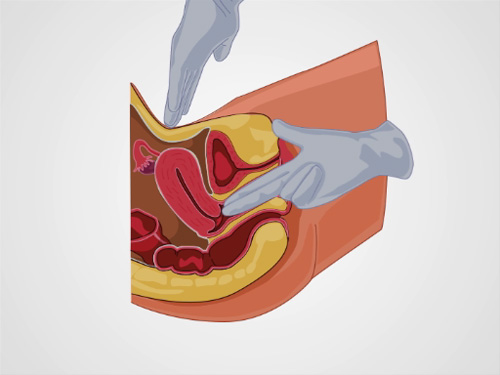Exploración pélvica III: Bimanual y examen rectovaginal
Visión general
Fuente:
Alexandra Duncan, GTA, Praxis clínica, New Haven, CT
Cocinero de Tiffany, GTA, Praxis clínica, New Haven, CT
Jaideep S. Talwalkar, MD, medicina interna y Pediatría, Facultad de medicina de Yale, New Haven, CT
Un examen bimanual es una comprobación minuciosa del cuello uterino, útero y los ovarios de un paciente. Puede decir a un experimentado proveedor de mucho, ya que puede ocasionar el descubrimiento de anormalidades, tales como quistes, fibromas o tumores malignos. Sin embargo, es útil incluso en la ausencia de estos hallazgos, ya que permite al médico establecer una comprensión de la anatomía del paciente para referencia futura.
Realizar el examen bimanual antes del examen de espéculo puede ayudar a relajarse a pacientes, mentalmente y físicamente, antes de lo que se percibe a menudo como la parte "más invasiva" del examen. Un practicante ya están familiarizado con la anatomía del paciente puede insertar un espéculo más sin problemas y cómodamente. Sin embargo, lubricación utilizado durante el examen bimanual puede interferir con ciertas muestras obtenidas durante el examen de espéculo de procesamiento. Proveedores deben estar familiarizados con el laboratorio local requisitos de procesamiento antes de comprometerse con un orden específico de examen.
Esta demostración comienza inmediatamente después del final del examen espéculo; por lo tanto, asume el paciente ha proporcionado una historia y está en la posición de litotomía modificada.
Un examen rectovaginal no siempre es necesario, pero puede realizarse para evaluar completamente un retroversión de útero y ovarios (esto puede ser la única manera de lograr una evaluación completa dependiendo de la posición uterina) o para evaluar el recto.
Procedimiento
1. examen bimanual

Figura 1. Examen bimanual. Correcta colocación de las manos del examinador para el examen bimanual.
- Prepare al paciente diciéndole, "Ahora colocar dos dedos enguantados en la vagina y use mi otra mano para presionar sobre el abdomen para evaluar el útero y los ovarios."
- Cubra totalmente los dos primeros dedos de la mano dominante con el lubricante.
- Sentarse y
Aplicación y resumen
Este vídeo repasa las técnicas para realizar un examen bimanual y rectovaginal cómodo. Al realizar primero el examen, puede ser difícil saber qué tanto las estructuras normales y las anormalidades deben sentirse como, pero la familiaridad se desarrolla con la práctica. Los profesionales experimentados pueden determinar la estructura y ubicación de la anatomía del paciente y descubrir pólipos, quistes y tumores malignos; el potencial de la enfermedad inflamatoria pélvica; y mucho más. El examen rectovaginal pue...
Tags
Saltar a...
Vídeos de esta colección:

Now Playing
Exploración pélvica III: Bimanual y examen rectovaginal
Physical Examinations II
147.7K Vistas

Examen de la vista
Physical Examinations II
77.2K Vistas

Oftalmoscopía
Physical Examinations II
68.0K Vistas

Examen de los oídos
Physical Examinations II
55.1K Vistas

Exploración de la nariz, senos paranasales, cavidad oral y faringe
Physical Examinations II
65.8K Vistas

Exploración de la tiroides
Physical Examinations II
105.0K Vistas

Exploración de ganglios linfáticos
Physical Examinations II
387.4K Vistas

Exploración abdominal I: Inspección y auscultación
Physical Examinations II
202.6K Vistas

Exploración abdominal II: Percusión
Physical Examinations II
248.2K Vistas

Exploración abdominal III: Palpación
Physical Examinations II
138.5K Vistas

Exploración abdominal IV: Evaluación de dolor abdominal agudo
Physical Examinations II
67.3K Vistas

Tacto rectal masculino
Physical Examinations II
114.5K Vistas

Exploración mamaria
Physical Examinations II
87.6K Vistas

Exploración pélvica I: Evaluación de los genitales externos
Physical Examinations II
307.1K Vistas

Exploración pélvica II: Examen con espéculo
Physical Examinations II
150.4K Vistas
ACERCA DE JoVE
Copyright © 2025 MyJoVE Corporation. Todos los derechos reservados
